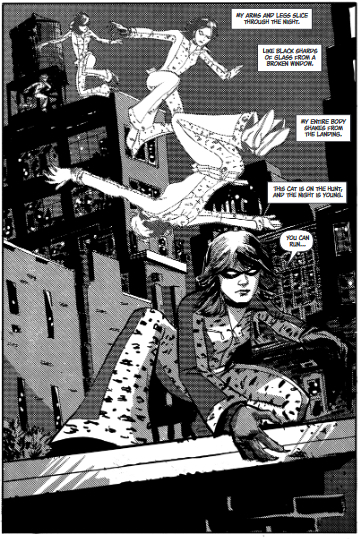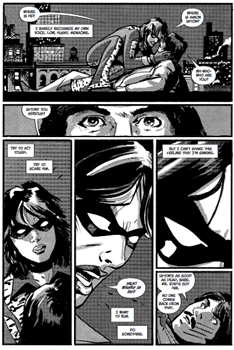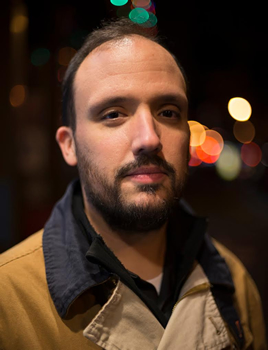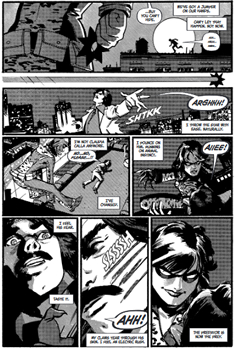

Up Close: Alex Segura
Four-Color Crime
In Alex Segura’s new standalone mystery SECRET IDENTITY—his first crime novel since wrapping up the celebrated Pete Fernandez series in 2019—a young Cuban-American woman has moved from Miami to New York with dreams of becoming a comic book writer. When the book begins, it’s 1975 and Carmen Valdez is working at Triumph Comics, a company that churns out books in the shadow of Marvel and DC. Carmen is a talented writer, but she’s stuck in an administrative role, making copies and fetching lunch for Triumph owner and editor-in-chief Jeffrey Carlyle. When a junior editor named Harvey Stern recruits Carmen to help him create a new superhero series for the company, she jumps at the chance. There’s an enormous catch, though: Carlyle has already nixed the idea of Carmen writing comics for him, so Harvey will take full credit until he decides the time is right to reveal that Carmen is his co-writer.
If the arrangement sounds dodgy, it gets worse. The series they create, about a female superhero known as the Legendary Lynx, is a hit, but Harvey is murdered before he comes clean about Carmen’s role. Carmen sets out to find his killer and claim some part of the character she helped create—a quest that’s complicated when her ex-girlfriend arrives from Miami and inserts herself in Carmen’s rapidly spiraling life.
If there’s anyone who seemed destined to write a rollicking murder mystery set in the underbelly of the comics business, it’s Segura. Besides authoring the Anthony-nominated Pete Fernandez books, Segura is a veteran of Archie Comics and DC Comics, and he’s currently the senior vice president of sales and marketing at comic book and graphic novel publisher Oni Press. Segura is the co-creator of the superhero noir comic The Black Ghost, and he has several new comics projects in the pipeline: NPR/Planet Money will release The Mysterious Micro-Face, while a new subscription-based platform called Zestworld has tapped Segura as part of its first wave of high-profile comics creators. Meanwhile, on Kickstarter, more than 900 backers have ponied up $43,000 and counting to help Segura and his collaborators publish The Dusk, a socially conscious vigilante superhero series.
In his latest interview with The Big Thrill, Segura talks about recreating the gritty world of the 1970s New York comics scene, channeling his own experiences as a Miami-to-New York transplant, and making his novel accessible to readers who might not share his love (and encyclopedic knowledge) of comics history.
Can you trace SECRET IDENTITY to a particular moment or incident that sparked the idea to write a noir murder mystery set in the ’70s New York comic book scene?
Two moments stand out for me. One was a long time ago—in college—while reading Michael Chabon’s magnificent Kavalier & Clay. I remember being mesmerized by it, and just wanting to immerse myself further in the world Chabon created. As an avid reader of not only comics, but genre fiction, I felt like I’d finally experienced a perfect synergy of my own obsessions with the book. One of the things I really wanted, though, was to immediately read the comics featuring the Escapist, the character the two protagonists create. Eventually, we got to see those meta comics created and published, but the idea of having comics woven into a prose narrative stuck with me.
The second moment came later, as an avid reader of mysteries. I’ve always been fascinated with Megan Abbott’s work and her ability to bring the tenets of noir to areas where you wouldn’t expect noir to exist—gymnastics, cheerleading, science, and so on. She crafts these narratives that are tense, fraught, and loaded with style outside of the typical noir settings. I remember reading Dare Me and just thinking, huh, wouldn’t it be cool to write a comic book noir? At the time, I was in the weeds writing my own PI series, but once I knew the Pete Fernandez Miami Mysteries would end, I realized it was the perfect time to dive into this idea.
Was there a moment or scene where Carmen really started to come into focus for you? If so, can you talk about it without spoiling anything?

Segura recruited artist Sandy Jarrell and letterer Taylor Esposito to create comic book pages from The Legendary Lynx, the superhero series co-created by SECRET IDENTITY’s heroine.
There’s a moment, early on, where Carmen is brainstorming with her colleague, Harvey. Carmen has tried everything to get some traction with her boss at Triumph Comics. She desperately wants to write comics. But he just sees her as his secretary and says as much. So when Harvey approaches her and asks if she’d want to co-write a new female superhero series with him (albeit anonymously), she figures she’s gonna take her shot. When we see them sit down and talk, Harvey is all over the place, but Carmen comes in and she’s buttoned up, prepared, and ready—she has notes, designs, everything. This is her dream, and she’s not going to miss her chance. I felt like that scene really summed her up as a character and put her into greater focus for me—and honestly, made me really care for her. It’s a turning point for her, I think, and I hope for the readers.
I feel like you had a lot of fun writing this book. I mean, like, a lot of fun. How did the experience of writing it compare to writing the Pete Fernandez books?
Oh, it was a blast. I love the Pete books—they mean so much to me personally and professionally. But this novel was just an adventure across the board, and I got to blend together all these things I love—comics, noir, Cuban-American life, Miami, New York, music—into something that I would’ve devoured as a reader. The old saying holds true—write the book you want to read that hasn’t been written yet, and this very much hit that sweet spot for me.
Like Carmen, you’re also a Miami native who moved to New York City, albeit in different eras. How does Carmen’s experience as a Miami-to-NYC transplant compare to your own?
Yeah, I pulled a lot from my own experience. I think as a Cuban-American in Miami, you feel very much like you’re part of the big conversation; you’re certainly not a marginalized community. I’ve mentioned this before, but I didn’t truly get a sense of being “other” until I moved to New York for the first time and felt it firsthand. It’s jarring, but also an important part of growing up. I also felt like that first year in New York—for me, for Carmen, for anyone—can be so, so lonely and strange, even though you’re surrounded by people and noise and lights. I wanted to reflect that sense of isolation despite being crowded into a small space. So in broad strokes our stories were similar, and our desires to write—and having that feeling that you couldn’t because of something out of your control—were similar, so I felt comfortable evoking that.
What makes the comic book industry of the 1970s such a great setting for a noir murder mystery?
It’s the contrast that I love. In the same way the Pete books were fun because you’ve got this tropical setting as a backdrop to these dark stories, the idea of comic books—at least in terms of the mainstream—is one of sharp colors, heroic actions, and all the “wham! pow! blam!” stuff—so to weave that into a dark, dangerous, and realistic crime story, it felt like a natural fit.
1975 is a particular low point for comics, too—before the comic shop market really took off, comic sales depended on newsstands. There wasn’t much of a secondary sales market; comic conventions were still just awkward gatherings in hotel ballrooms vs. the massive pop culture events we see today, and the people working in comics were either diehard fans just happy to be there or people looking for a paycheck before they moved on to do something else. A stark contrast to today, where comics are everywhere—we have a Peacemaker TV show, Ant-Man movies…comics are all over pop culture, and creators flock to comics to tell stories and control their ideas. It’s totally different. I wanted to showcase an industry from a different time and what a fan like Carmen might have had to do to achieve her dream—and the cost that would come with succeeding.
How much thought did you give to making the story accessible to readers who aren’t familiar with comic book history or the comics industry?
That was a balance I thought was really important to strike. I think as it reads now, the novel is loaded with Easter eggs—names, characters, creator nods, you name it. But if you come into it with no deep knowledge of comics, that stuff won’t slow you down. I wanted to avoid Wikipedia-ing anything, to have scenes that just felt performative or “Hey look I know comics.” Which was challenging, because you want to get everything in there. But it goes back to killing your darlings, I guess? As much as I tried to make sure the story was accurate, evoked the time period, and had enough hat tips to entertain the core comics reader, at the end of the day it’s a mystery novel and I want people looking for a good yarn to not get lost in the sauce.
Tell me about recruiting Sandy Jarrell and Taylor Esposito to draw and letter SECRET IDENTITY’s comic book pages.

Segura hopes the comics pages in SECRET IDENTITY will create what he calls a “’meta conversation’ with the prose—giving readers a break from the main narrative to experience something from that world that adds texture and tone to the bigger picture.”
I’ve known Sandy forever—we’ve been wanting to work together for well over a decade. He’s not just an amazing artist and storyteller, but he loves the history of comics. His style is timeless, and he leans hard on narrative. I can just give him a few sentences and he can create an entire sequence. Once I knew that Secret Identity would feature comic sequences—this was before we’d even sold the book, mind you, I was still writing it—Sandy was the first person that came to mind. We worked in what’s now called the Marvel method—meaning, I’d give him a broad idea of what the page would be—a few sentences, really, like: “the Lynx is cornered, we see X or Y, and let’s go for a Frank Miller/Daredevil vibe” and he’d take that and do a rough layout of the page. I’d give notes, and he’d finalize—then I’d write the lettering script (dialogue, captions, sound effects), and Taylor, who is a total pro, would do that last lettering pass over Sandy’s final art. The end result is something that we hope evokes the era and looks like something that could theoretically have been on the stands around the time, while also having what I like to call a “meta conversation” with the prose—giving readers a break from the main narrative to experience something from that world that adds texture and tone to the bigger picture.
What’s the most surprising thing you learned while researching SECRET IDENTITY?
I think the stories that really resonated with me are also the crux of SECRET IDENTITY, the idea of your idea getting away from you. There are so many instances where creators poured themselves into ideas only to see them come to life on their own, after the originator left, got fired, or moved on—not truly knowing the value of what they’d brought to the table. I wanted to take that thought and run it through the prism of a murder mystery, but in many ways the novel is a conversation about where ideas come from and what happens when we lose control of them.
What can you share about what you’re working on next?
In terms of novels, I’m starting my next book for Flatiron—I can’t really share what it’s about yet. My NPR/Planet Money comic book, The Mysterious Micro-Face, with art by Jamal Igle, is hitting in the next few months, my new comic book series for Zestworld, The Awakened (a superhero noir), with co-writer Michael Moreci and artist Dean Kotz, is ramping up, and I have a few other comic book projects in the hopper that I’m excited to talk about soon. And The Dusk Kickstarter is close to completion, so I’m looking forward to getting that in the hands of our patient backers! Always busy is my mantra, haha.
- AudioFile Spotlight: March Mystery and Suspense Audiobooks - March 17, 2025
- Africa Scene: Shadow City by Natalie Conyer - March 17, 2025
- The Ballad of the Great Value Boys by Ken Harris - February 15, 2025



